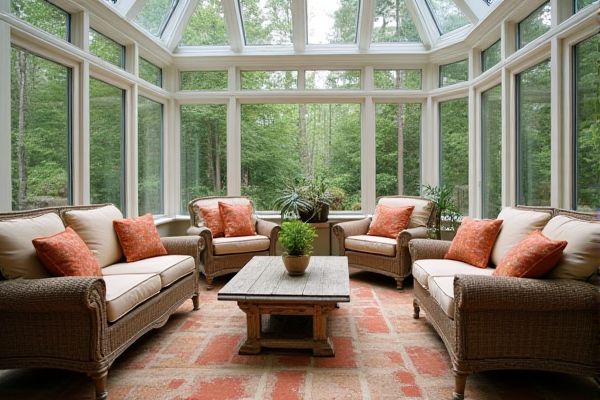
Weatherproof furniture is designed with durable materials like treated wood, metal, or synthetic wicker to withstand sun exposure, moisture, and temperature fluctuations, making it ideal for sunrooms or outdoor spaces. Understanding these benefits can help you choose the right furniture for your sunroom; explore the rest of the article to learn more about maintaining and selecting the best pieces for your space.
Table of Comparison
| Feature | Weatherproof Furniture | Indoor-only Furniture (Sunroom) |
|---|---|---|
| Material Durability | Resistant to rain, UV rays, humidity, and temperature changes | Designed for controlled indoor environments; not resistant to moisture or UV |
| Maintenance | Low maintenance; easy to clean and resistant to mold and mildew | Requires careful cleaning; can degrade if exposed to moisture or sun |
| Lifespan | Long-lasting in outdoor conditions | Shorter lifespan if exposed to outdoor elements |
| Comfort | May be less cushioned but eco-friendly options available | Typically more cushioned and designed for indoor comfort |
| Design | Functional designs suitable for outdoor aesthetics | Varied styles suited to interior decor |
| Cost | Generally higher due to durable materials | Varies; often less expensive but may incur replacement costs if damaged |
Understanding Weatherproof and Indoor-Only Furniture
Weatherproof furniture is constructed with durable materials such as aluminum, teak, or synthetic wicker designed to resist moisture, UV rays, and temperature fluctuations, making it ideal for sunrooms with occasional outdoor exposure. Indoor-only furniture typically features fabrics and finishes that can easily degrade when exposed to sunlight or humidity, limiting their use to protected environments with controlled climate. Choosing weatherproof furniture ensures longevity and low maintenance in sunroom settings that experience varying weather conditions.
Key Material Differences
Weatherproof furniture for sunrooms is constructed using materials like aluminum, teak, synthetic rattan, and powder-coated steel to resist moisture, UV rays, and temperature fluctuations, ensuring durability in varying weather conditions. Indoor-only furniture typically uses wood, fabric upholstery, and untreated metals, which lack resistance to sun exposure and humidity, making them prone to fading, warping, and mold growth. The key material differences focus on weatherproof furniture's use of synthetic, treated, and coated materials engineered for longevity, while indoor furniture prioritizes aesthetics and comfort without protective finishes.
Durability and Longevity Comparison
Weatherproof furniture is engineered with materials like aluminum, teak, or synthetic wicker designed to resist moisture, UV rays, and temperature fluctuations, ensuring superior durability and longevity in sunroom environments exposed to varying weather conditions. Indoor-only furniture, often constructed from untreated wood or delicate fabrics, is susceptible to warping, fading, and mold growth when exposed to sunlight and humidity common in sunrooms. Choosing weatherproof furniture enhances your investment by maintaining structural integrity and aesthetic appeal over time, even under challenging environmental stress.
Maintenance Requirements
Weatherproof furniture requires minimal maintenance due to its resistance to moisture, UV rays, and temperature fluctuations, often needing only occasional cleaning with mild soap and water. Indoor-only furniture in a sunroom demands more frequent upkeep to prevent damage from sunlight exposure and humidity, such as regular dusting, polishing, and protection against fabric fading or warping. Proper maintenance extends the lifespan and appearance of both types, but weatherproof materials like aluminum, resin wicker, and treated wood are inherently more durable in semi-outdoor environments.
Comfort and Style Considerations
Weatherproof furniture designed for sunrooms offers enhanced durability without compromising on comfort, featuring materials like all-weather wicker and UV-resistant cushions that resist fading and moisture. Indoor-only furniture often prioritizes plush fabrics and delicate finishes, delivering superior softness and intricate design details ideal for a controlled environment. Your choice depends on balancing the need for style longevity in variable conditions with the desire for maximum comfort indoors.
Cost Analysis: Investment and Value
Weatherproof furniture typically requires a higher initial investment due to durable materials like synthetic wicker, metal, or treated wood designed to withstand outdoor elements. Indoor-only furniture for sunrooms often costs less upfront but may incur additional expenses over time from damage caused by sunlight, humidity, or temperature fluctuations. When assessing value, your budget should consider not only purchase price but also longevity, maintenance costs, and replacement frequency to ensure the best return on investment.
Adaptability to Sunroom Environments
Weatherproof furniture offers superior adaptability to sunroom environments by resisting moisture, UV rays, and temperature fluctuations, ensuring durability and maintaining appearance over time. Indoor-only furniture lacks these protective treatments, making it susceptible to fading, warping, and mold when exposed to the variable conditions common in sunrooms. Choosing weatherproof materials such as aluminum, synthetic wicker, or treated wood extends furniture lifespan and retains comfort in sunroom settings.
Aesthetics: Matching Décor and Themes
Weatherproof furniture designed for sunrooms offers a versatile aesthetic that seamlessly blends with outdoor-inspired decor and natural themes, enhancing the transitional space between indoor and outdoor living. Indoor-only furniture often features delicate materials and intricate designs better suited for controlled environments, allowing for greater creativity in matching specific interior themes. Choosing weatherproof pieces ensures durability without sacrificing style, maintaining vibrant colors and finishes despite exposure to sunlight and humidity.
Environmental Impact and Sustainability
Weatherproof furniture made from recycled or sustainably sourced materials significantly reduces environmental impact by minimizing waste and the need for frequent replacement, unlike indoor-only furniture which often requires protection from sunroom elements leading to potential premature wear. Your choice of weatherproof options supports long-term sustainability by withstanding humidity, UV rays, and temperature fluctuations without degrading, reducing the carbon footprint associated with manufacturing and disposal. Investing in durable, eco-friendly weatherproof furniture promotes resource conservation and aligns with environmentally conscious living in sunroom spaces.
Choosing the Right Furniture for Your Sunroom
Selecting weatherproof furniture for your sunroom ensures durability against humidity, temperature fluctuations, and potential sun exposure, maintaining appearance and structural integrity over time. Indoor-only furniture, while often offering a wider range of style options and comfort, is vulnerable to moisture damage and fading without proper environmental control. Prioritize materials such as aluminum, teak, or synthetic wicker for weatherproof options, and use UV-resistant fabrics to enhance longevity in sunroom settings.
 homyna.com
homyna.com